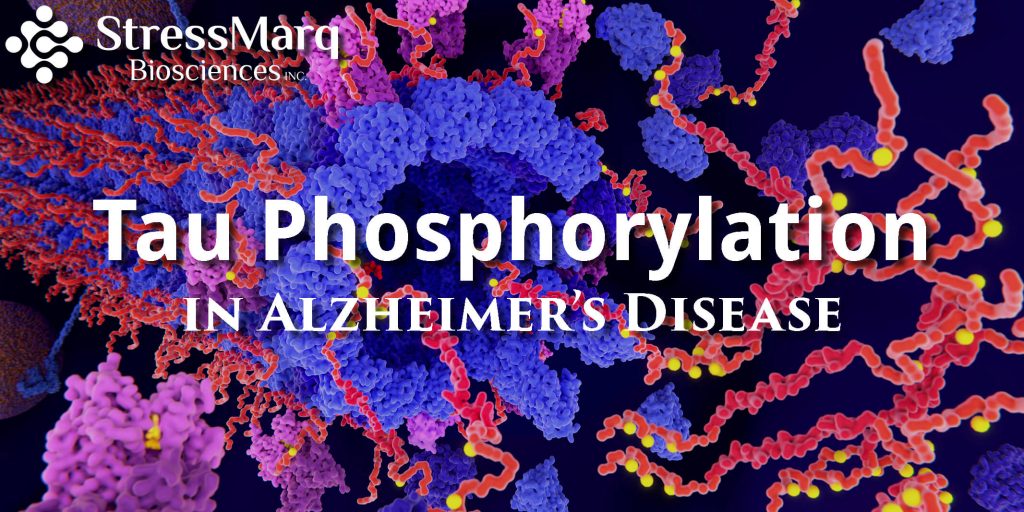Tau Phosphorylation in Alzheimer’s Disease
Introduction to Tau Phosphorylation
Since it was first isolated from the porcine brain in 1975, tubulin-associated unit (tau) has been widely studied for its role in neurodegeneration1. Under normal conditions, tau predominantly localizes to neuronal axons where it functions to promote assembly and stability of microtubules. However, a group of neurodegenerative diseases known as tauopathies are characterized by abnormal aggregation and hyperphosphorylation of tau within neuronal cells. The most prevalent of these is Alzheimer’s Disease, a condition recently estimated to have a global societal cost of approximately US$1 trillion2. Despite significant efforts by researchers, Alzheimer’s Disease currently has no known cure.
How can tau pathology be detected?
Alzheimer’s Disease is characterized by an accumulation within the brain of two types of protein aggregate – extraneuronal amyloid fibers composed of the amyloid β peptide, and intraneuronal neurofibrillary tangles consisting mainly of hyperphosphorylated tau3. The distribution pattern of the neurofibrillary tangles has, for many years, formed the basis of a biochemical staging system to differentiate initial, intermediate, and late phase Alzheimer’s Disease4. Using Gallyas silver staining of post-mortem sections taken from different regions of the brain, this approach assigns a given Alzheimer’s Disease case one of six defined stages (Braak stages).
Despite widespread use, the silver stain method has had to evolve to meet the demands of modern laboratories5. Now, rather than analyzing by eye thick (100µM) tissue sections embedded in polyethylene glycol (PEG), researchers instead embed thin (5-15µM) sections in paraffin and use monoclonal antibodies for automated immunodetection. The first of these antibodies to enter mainstream use was AT8, which has been epitope mapped to the pSer202/pThr205 region of hyperphosphorylated tau6,7. Although AT8 recognizes the same phosphorylation pattern on the fetal protein, the antibody has demonstrated proven utility in specifically staining the affected brain regions of patients with Alzheimer’s Disease.
What is the role of phosphorylation at Ser202 and Thr205?
Phosphorylation is one of several post-translational modifications (PTMs) required for tau aggregation. Others include truncation, acetylation, ubiquitination, and sumoylation, yet phosphorylation is the best characterized PTM in Alzheimer’s Disease to date8. With over 70 potential phosphorylation sites distributed throughout the entire protein structure, many in clusters, the study of tau phosphorylation is extremely challenging. However, several residues flanking the microtubule binding domains of human tau are particularly implicated in neurodegeneration9.
Of these, the pSer202/pThr205 residues recognized by AT8 have been the focus of numerous studies. Recently, it has been shown that phosphorylation at these sites in combination with Ser208 phosphorylation and an absence of phosphorylation at Ser262 produces a protein that readily forms fibers10. Moreover, the levels of pTau at these residues is increased in Braak stage V/VI, highlighting that different phosphorylation profiles are associated with Alzheimer’s Disease progression8.
Supporting the study of Tau phosphorylation in Alzheimer’s disease
StressMarq offers a comprehensive portfolio of reagents to support Alzheimer’s disease research. Included among these, our rabbit monoclonal Tau antibody (pSer202/ pThr205) is a popular alternative to AT8. Benefiting from low background, SMC-601 is validated for Western blot, dot blot, and immunocytochemistry/immunofluorescence.
![Rabbit Anti-Tau Antibody (pSer202/ pThr205) [AH36] used in Immunocytochemistry/Immunofluorescence (ICC/IF) on Human iPSC-derived cortical excitatory neurons (SMC-601)](https://www.stressmarq.com/wp-content/uploads/SMC-601_Tau_Antibody_AH36_ICC-IF_Human_iPSC-derived-cortical-excitatory-neurons_1-148x300.png)
Immunocytochemistry/Immunofluorescence analysis using Rabbit Anti-Tau Monoclonal Antibody, Clone AH36 (SMC-601). Tissue: iPSC-derived cortical excitatory neurons. Species: Human. Primary Antibody: Rabbit Anti-Tau Monoclonal Antibody (SMC-601) at 1:500 for Overnight. Secondary Antibody: Donkey anti-rabbit: Alexa Fluor 488 at 1:1000. Counterstain: DAPI. A) iPSC-derived neurons from non-demented control (NDC). B) iPSC-derived neurons from subject with P301L MAPT mutation. Images acquired using an automated Opera Phoenix system. Each field of view is a max projection from 10 planes of 1 um stacks.
References
- A protein factor essential for microtubule assembly, Weingarten MD et al, Proc Natl Acad Sci U S A. 1975 May;72(5):1858-62
- https://www.alz.co.uk/research/world-report-2018
- Tau Protein Hyperphosphorylation and Aggregation in Alzheimer’s Disease and Other Tauopathies, and Possible Neuroprotective Strategies, Šimić G et al, Biomolecules. 2016 Jan 6;6(1):6
- Neuropathological stageing of Alzheimer-related changes, Braak H and Braak E, Acta Neuropathol. 1991;82(4):239-59
- Staging of Alzheimer disease-associated neurofibrillary pathology using paraffin sections and immunocytochemistry, Braak H et al, Acta Neuropathol. 2006 Oct;112(4):389-404
- Monoclonal antibody AT8 recognises tau protein phosphorylated at both serine 202 and threonine 205, Goedert M et al, Neurosci Lett. 1995 Apr 21;189(3):167-9
- A Phosphorylation-Induced Turn Defines the Alzheimer’s Disease AT8 Antibody Epitope on the Tau Protein, Gandhi NS et al, Angew Chem Int Ed Engl. 2015 Jun 1;54(23):6819-23
- Phosphorylation of different tau sites during progression of Alzheimer’s disease, Neddens J et al, Acta Neuropathol Commun. 2018 Jun 29;6(1):52
- Tau Phosphorylation Sites Work in Concert to Promote Neurotoxicity In Vivo, Steinhilb ML et al, Mol Biol Cell. 2007 Dec;18(12):5060-8
- Identification of the Tau phosphorylation pattern that drives its aggregation, Despres C et al, Proc Natl Acad Sci U S A. 2017 Aug 22;114(34):9080-9085


Leave a Reply